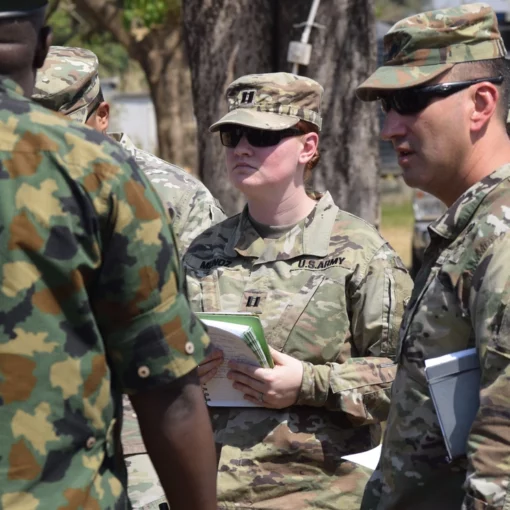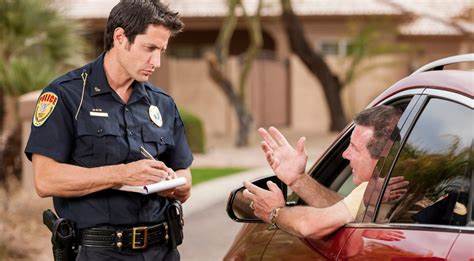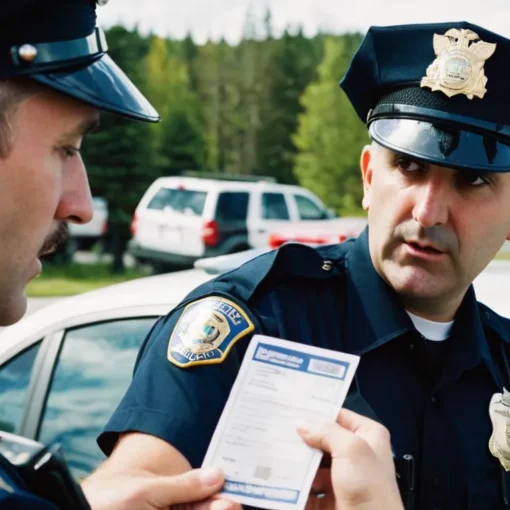The sight of police lights flashing in the rearview mirror can evoke a range of emotions, from anxiety to confusion. As a driver, encountering such a situation can lead to uncertainty about what it signifies. In this comprehensive overview, we will delve into five possible meanings behind a police vehicle activating its lights behind you, shedding light on the potential reasons and outcomes of such an encounter.
Cops Lights Behind Me: What Does It Mean?
1. Routine Traffic Stop:
One of the most common scenarios when a police officer puts their lights behind you is a routine traffic stop. Law enforcement officers use their vehicle’s lights to signal a driver to pull over for a variety of reasons, such as speeding, running a red light, or committing a minor traffic violation. This serves as an opportunity for officers to ensure road safety, educate drivers about traffic laws, and potentially issue citations or warnings. It’s important for drivers to remain calm, follow instructions, and cooperate with officers during such stops to ensure a smooth interaction.
2. Suspected Violation of the Law:
Police lights behind you may also indicate that law enforcement suspects you might have been involved in a criminal activity. This could range from suspicion of driving under the influence (DUI) to more serious offenses like a hit-and-run or reckless driving. In these cases, officers might activate their lights to initiate a stop and investigate the situation further. If you find yourself in this situation, it’s crucial to comply with officer instructions, as any resistance could escalate the encounter and lead to additional charges.
3. Emergency Response:
Another possible reason for police lights behind you could be an emergency response situation. Law enforcement vehicles often use their lights and sirens to navigate through traffic quickly in order to reach the scene of an emergency, such as a crime in progress or an accident. If you notice a police vehicle approaching with lights and sirens activated, it’s important to yield the right of way and provide a clear path for them to pass safely.
4. Assistance Required:
Sometimes, police officers might activate their lights to signal that they need your assistance. This could involve needing your vehicle as a barrier to protect them during a traffic stop or to block off a section of road for a safety-related issue. In such cases, it’s crucial to follow their instructions carefully and help them ensure the safety of everyone involved.
5. Administrative Check:
Police lights behind you might also be a signal that an officer is running an administrative check on your vehicle. This could involve verifying your license, registration, and insurance status. In some cases, officers might also be checking for outstanding warrants or any other relevant information tied to your vehicle. While this may cause a brief delay, it’s important to remain patient and cooperative during the process.
Encountering police lights behind you can trigger a range of emotions, but understanding the potential reasons behind this action can help alleviate some of the uncertainty. From routine traffic stops to emergency responses and administrative checks, there are various explanations for why a police officer might activate their lights behind you. Regardless of the reason, it’s essential to remain calm, follow instructions, and prioritize safety for both yourself and law enforcement officers. By adhering to these principles, you can navigate such situations with confidence and ensure a positive outcome.
What Does Different Colors Of Police Lights Mean?
Encountering police lights behind you can trigger a range of emotions, from concern to uncertainty. However, understanding the significance of different-colored police lights can provide valuable insights into the situation at hand. In this comprehensive exploration, we will delve into the meanings behind various colors of police lights, shedding light on their significance and what drivers should do when they encounter them.
1. Blue Lights: A Signal for Law Enforcement Presence:
Blue lights are perhaps the most common color associated with police vehicles. When you see blue lights activated behind you, it typically signifies the presence of law enforcement. This can be during routine patrols, traffic stops, or when officers are responding to incidents. Blue lights serve as a universal indication that you should be prepared for police activity. In this scenario, it’s important to follow standard traffic rules, signal your intention to pull over, and cooperate with any instructions from the officer.
2. Red Lights: Urgency and Emergency Response:
Red lights on a police vehicle usually indicate an emergency situation. When officers are responding to urgent calls or emergencies such as accidents, fires, or crimes in progress, they activate their red lights along with sirens. If you notice red lights flashing behind you, it’s crucial to yield the right of way and create a clear path for the police vehicle to pass. Pull over to a safe spot if possible and allow the officer to proceed without obstruction.
3. White Lights: Illuminating the Scene:
White lights are commonly used by law enforcement vehicles to illuminate the area around them. They may be used in combination with other colored lights to provide better visibility during traffic stops or when officers are investigating incidents during nighttime hours. If you see white lights activated, it’s a sign that officers are enhancing visibility for their safety and the safety of others. Continue driving normally but be cautious and attentive to your surroundings.
4. Amber or Yellow Lights: Caution and Traffic Management:
Amber or yellow lights are often used by law enforcement for cautionary purposes. These lights can be seen on vehicles that are conducting traffic management, directing traffic flow, or assisting with road closures. When you encounter vehicles with amber lights, slow down, be prepared for changes in traffic patterns, and follow any instructions given by officers.
5. Green Lights: Specialized Units and Clearing Intersections:
Green lights are less common and are usually associated with specialized law enforcement units, such as traffic management teams or other specialized response units. In some cases, green lights might be used to clear intersections or signal that the vehicle is authorized to proceed through traffic without stopping. If you see a police vehicle with green lights, exercise caution and yield the right of way when appropriate.
Different-colored police lights serve as visual cues that provide important information to drivers about the intentions and activities of law enforcement officers. Blue lights indicate their presence, red lights signify emergencies, white lights enhance visibility, amber or yellow lights represent caution, and green lights often indicate specialized units or authorized movement. Understanding these distinctions empowers drivers to respond appropriately and safely when encountering police lights behind them, contributing to smoother interactions and improved road safety.
RELATED:
Is Accepting A Deferred Prosecution Agreement An Admission Of Guilt?
Can An Adult Be Tried For A Crime They Committed As A Minor?
Can A Defendant Remain Silent During Cross Examination (Invoke 5th Amendment)?
What To Do When Police Lights Are Behind You
Encountering police lights behind your vehicle can be a nerve-wracking experience, but understanding how to respond in such situations is crucial for ensuring your safety and maintaining a positive interaction with law enforcement. In this comprehensive guide, we will explore seven important actions that individuals should take when they see a police vehicle’s lights activated behind them.
1. Remain Calm and Stay Alert:
When you notice police lights behind you, the first and most important thing to do is remain calm and composed. It’s natural to feel anxious, but panicking can lead to poor decision-making. Take a deep breath, keep your hands on the steering wheel in a visible position, and focus on the road and your surroundings.
2. Signal Your Intentions:
If you’re in traffic, safely signal your intention to pull over to the side of the road. Use your turn signal to indicate your movement, and gradually slow down. Avoid making sudden or erratic movements that could raise suspicion or concern for the officer.
3. Find a Safe Spot:
When pulling over, choose a location that is well-lit and safe for both you and the officer. If you’re on a busy road, look for a wide shoulder or a nearby parking lot. Ensure there’s enough space for the police vehicle to park behind you without obstructing traffic.
4. Turn on Interior Lights:
As you pull over, turn on your vehicle’s interior lights if it’s dark outside. This action provides the officer with a clear view of the interior and your actions, which can help alleviate any concerns they might have about their safety.
5. Keep Your Hands Visible:
Once you’ve stopped your vehicle, keep your hands on the steering wheel where they’re easily visible to the officer. This gesture demonstrates your compliance and reduces the likelihood of misunderstandings. Avoid reaching for items unless instructed to do so by the officer.
6. Cooperate and Communicate:
When the officer approaches your vehicle, follow their instructions while remaining polite and respectful. If they ask for identification, inform them of its location before reaching for it. If you’re unsure about their request, don’t hesitate to ask for clarification. Remember that showing cooperation can go a long way in defusing tense situations.
7. Know Your Rights:
It’s important to be aware of your rights during a traffic stop, but it’s equally important to exercise them in a respectful manner. You have the right to remain silent and the right to an attorney. If you believe your rights are being violated, it’s best to address the issue later through appropriate channels rather than engaging in a confrontational manner during the stop.
Encountering police lights behind you can be a daunting experience, but responding appropriately is key to ensuring a safe and positive outcome. Remaining calm, signaling your intentions, finding a safe spot, and following officer instructions are all crucial steps. By keeping your hands visible, cooperating, and understanding your rights, you can contribute to a smooth interaction with law enforcement. Remember that the goal is to ensure everyone’s safety and resolve the situation without unnecessary tension.
Last updated on: April 24, 2024




